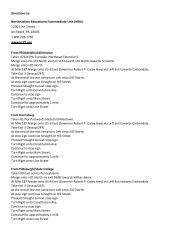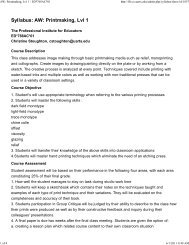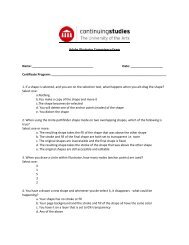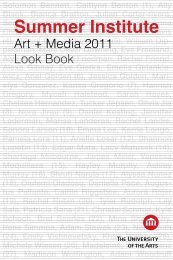University of The Arts, Teaching Artist Certification Program
University of The Arts, Teaching Artist Certification Program
University of The Arts, Teaching Artist Certification Program
Create successful ePaper yourself
Turn your PDF publications into a flip-book with our unique Google optimized e-Paper software.
Course Descriptions<br />
Foundations <strong>of</strong> Learning <strong>The</strong>ory<br />
Year 1 – fall<br />
This course explores the history and philosophy <strong>of</strong><br />
various learning theories as the precursors to presentday<br />
classroom practices. <strong>The</strong>oretical models from<br />
pre-20th century through current brain based<br />
research are examined in relation to the teaching <strong>of</strong><br />
the arts. Learning styles and teaching strategies are<br />
analyzed as a means to enhancing effective practices<br />
in the classroom.<br />
Pr<strong>of</strong>essional Practices for <strong>Artist</strong>s +<br />
Designers<br />
Year 1 – fall<br />
This course focuses on the practical and business<br />
skills needed to support and sustain a working<br />
pr<strong>of</strong>essional artist. It addresses specific demands<br />
outside <strong>of</strong> working in the studio and making art. In<br />
addition to examining current trends and transitions<br />
in the field, students develop traditional presentation<br />
materials, which are central when applying to most<br />
opportunities. This includes writing artist statements<br />
and cover letters, shooting digital images and other<br />
variables <strong>of</strong> a presentation packet. Through lectures,<br />
student research projects, trips to venues and class<br />
discussions, study galleries and alternative venues<br />
(mostly through local examples), grants and residencies,<br />
commissions, taxes, contracts, record keeping, and<br />
basic do’s and don’ts. Guest speakers from the local<br />
arts community are scheduled to discuss different<br />
aspects <strong>of</strong> the business <strong>of</strong> art.<br />
Methods + <strong>Teaching</strong> Practicum<br />
Year 1 – spring<br />
Develop knowledge <strong>of</strong> state and federal arts and<br />
humanity standards, a familiarity with PreK-12 core<br />
curricula, and an alignment <strong>of</strong> arts skills within the<br />
curriculum. Build an understanding <strong>of</strong> best practices<br />
in community settings, including the culture <strong>of</strong> the<br />
community and working across generations. Learn<br />
how to build and implement an array <strong>of</strong> methodologies<br />
and instruments to assess student learning through<br />
strategies appropriate for residencies. This course<br />
focuses on how to design, implement and assess arts<br />
residency programs.<br />
Child Development/Human Behavior<br />
Year 1 – spring<br />
<strong>The</strong> purpose <strong>of</strong> this course is to provide teaching artists<br />
with a basic understanding <strong>of</strong> developmental theories<br />
and concepts as they relate to patterns <strong>of</strong> change in<br />
learners across the life span. Cognitive, language,<br />
social/emotional, and motor domains are examined.<br />
Consideration is given to the application <strong>of</strong> learning<br />
theories within instructional settings from PreK-12<br />
classrooms to community sites and to the ways teaching<br />
artists can create environments that promote effective<br />
student learning.<br />
<strong>Arts</strong> Integration + Collaboration<br />
Year 1 – summer<br />
This course focuses on integrating the arts across the<br />
curriculum to drive learning in and through the arts. It<br />
also develops the collaboration skills <strong>of</strong> teaching artists<br />
to co-plan and co-teach with teachers/arts specialists<br />
in PreK-12 classrooms and community sites. Guest<br />
speakers, primarily PAEP rostered <strong>Artist</strong>s-in Residence,<br />
are featured as they present methods to incorporate<br />
and apply arts across the curriculum. Models <strong>of</strong><br />
collaborative work developed between both classroom<br />
instructors and pr<strong>of</strong>essional artists in visual and<br />
performing arts are studied in relation to academic<br />
standards and effective student learning projects.<br />
<strong>Teaching</strong> artists build on skills acquired in Methods<br />
and <strong>Teaching</strong> Practicum.<br />
<strong>Program</strong> Management + <strong>Program</strong><br />
Assessment<br />
Year 1 – summer<br />
This course teaches strategies for managing all aspects<br />
<strong>of</strong> artist residencies including how to facilitate program<br />
collaboration. Course content focuses on integrating<br />
evaluation with project planning, assessing residency<br />
programs, identifying challenges and barriers, and<br />
developing strategies for success in PreK-12 classrooms<br />
and community sites.<br />
Capstone <strong>The</strong>sis Project<br />
Year 2 – fall<br />
Demonstrate application <strong>of</strong> theory into practice.<br />
Through field placements, teaching artists observe and<br />
assist master artists in a residency setting. <strong>Artist</strong>s then<br />
design and implement a 15-session arts integrated<br />
project under the supervision <strong>of</strong> a residency mentor<br />
in a school or community site. Walk away with experience<br />
and a model lesson plan that can be used in a<br />
future residency.






